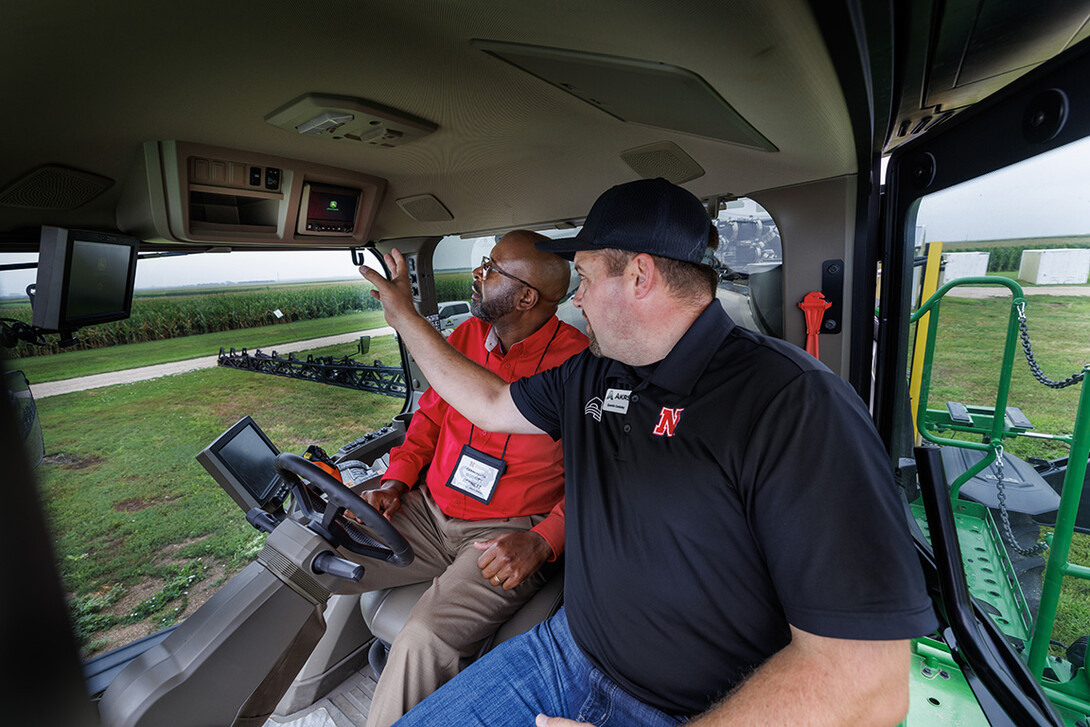
Rodney Bennett, the University of Nebraska–Lincoln’s new chancellor, embraced his new state during a three-day, 1,000 plus-mile bus tour of landmarks and university facilities from Nebraska City to Scottsbluff and points in between.
Along the way, the chancellor, his wife, Temple, and other participants in the Aug. 1-3 “IANR Roads Scholar” tour were given a bird’s eye view of the past, present and future of Nebraska’s agriculture-based economy.
“The sites we are visiting provide a holistic view and an important reminder of the partnership between the university and Nebraska’s agriculture and natural resources community,” Bennett said after activities at South Central Agriculture Laboratory near Clay Center Aug. 1. “Each component we have seen is important, individually and in and of itself, but bringing it together into a large picture shows how the university’s support of Nebraska’s agriculture and natural resources community benefits all of us.”
The Roads Scholar tour is intended to familiarize newly hired faculty with the statewide scope of UNL’s Institute of Agriculture and Natural Resources. About two dozen UNL faculty, staff and administrators joined this year’s tour, which received coverage by the Lincoln Journal Star and several western Nebraska news outlets.
“Now, not only can you talk about Kimmel Orchard, you’ve had the apple fritter there, you’ve been on the hayrack ride,” Bennett told Journal Star higher education reporter Chris Dunker after visiting the Nebraska City orchard and vineyard that frequently partners with the university. “It isn’t an abstract concept anymore, it’s something that becomes part of you, whether you’re in Lincoln or another part of the state or even the world.”
At Homestead National Historic Park, where America’s “first” homesteader, Daniel Freeman, claimed land outside present-day Beatrice on Jan. 1, 1863, park rangers provided Bennett and his travel companions an unflinching account of both the triumph and heartbreak behind Nebraska’s homesteading history. Later, the group examined a weather-beaten 1945 Allis Chalmers Model C tractor used by the last homesteader, Ken Deardorff, on an 80-acre claim in Alaska in the 1970s. Students in UNL’s Tractor Restoration Club prepared the vintage Allis for exhibit at the Beatrice-area museum after it was retrieved from Alaska in 2017.
Later, at the South Central Agriculture Laboratory, Bennett climbed aboard a massive John Deere See and Spray 612R self-propelled spraying rig. The $700,000 rig, on loan from the AKRS John Deere dealership, features two 60-foot folding booms and 36 computerized cameras with the ability to distinguish weeds from crops, so that weeds can be precisionally targeted with herbicide.
The tour launched July 31 with a get-together at the University of Nebraska State Museum at Morrill Hall on campus and concluded Aug. 3 with a dinner at Milletta Vist Vineyard outside St. Paul.
Other stops were Kimmel Orchard and Vineyards near Nebraska City; Golden Spike Tower, located at the world’s largest railroad classification yard in North Platte; UNL’s West Central Research, Extension and Education Center outside North Platte; Lake McConaughy Visitors Center and Water Interpretive Center near Ogallala; Scotts Bluff National Monument in Scotts Bluff County; Legacy of the Plains Museum in Gering; UNL’s Panhandle Research, Extension and Education Center in Scottsbluff; and UNL’s Gudmundsen Sandhills Laboratory, a 12,800-acre working ranch in Grant, Hooker and Cherry Counties.
The tour’s aim is to forge a tighter connection between UNL faculty and the people and places of Nebraska, said Mike Boehm, Harlan vice chancellor for IANR. It introduces new faculty to resources for their teaching, research, Extension and engagement efforts, as well as orienting them to the needs and issues facing the state.

“Nebraska is such an amazing place, a magical combination of people and places,” Boehm said. “The goal for the tour is to give our new faculty a sense of that magic, as well as a point of reference as they build their programs.”
Mark Stone, selected to head Nebraska’s Biological Systems Engineering program in January, said the tour built camaraderie among new faculty members. A native of Laurel, Nebraska, Stone previously served as a professor of civil, construction and environmental engineering at the University of New Mexico.
“The chancellor’s presence adds a layer of excitement and fun and demonstrates how important IANR is in his eyes,” Stone added.
While bouncing along in a hayrack through the Kimmel orchards, Bennett laughed loudly at a series of silly fruit jokes told by intern Emily Martindale, a UNL junior and agriculture education major.
Examples: “What do you call it when your friends encourage you to eat more fruit? Pear Pressure.” “What do you call an apple that plays the trumpet? A tooty-frooty.” “What do you call the time in between eating a load of peaches? A pit stop.”
From the platform of the See and Spray rig, Bennett pretended to launch his first State of the University address before he took a seat in the cab for a quick lesson on the sprayer’s control panel.

Boehm said the chancellor’s participation sends powerful messages about building relationships with faculty and his commitment to the university’s partnership with Nebraska agriculture and those who steward the state’s water and soils.
“He’s sending a message to the people of Nebraska that the entire state is part of the UNL campus — and he’s not wasting any time getting started,” Boehm said.
These media outlets also featured stories about Bennett’s participation in the Roads Scholar tour: Rural Radio Network (KNEB), Scottsbluff, NBC Nebraska, Scottsbluff, and Scottsbluff Star-Herald.
KRVN’s Chat with a Chancellor feature was recorded prior to the trip.







